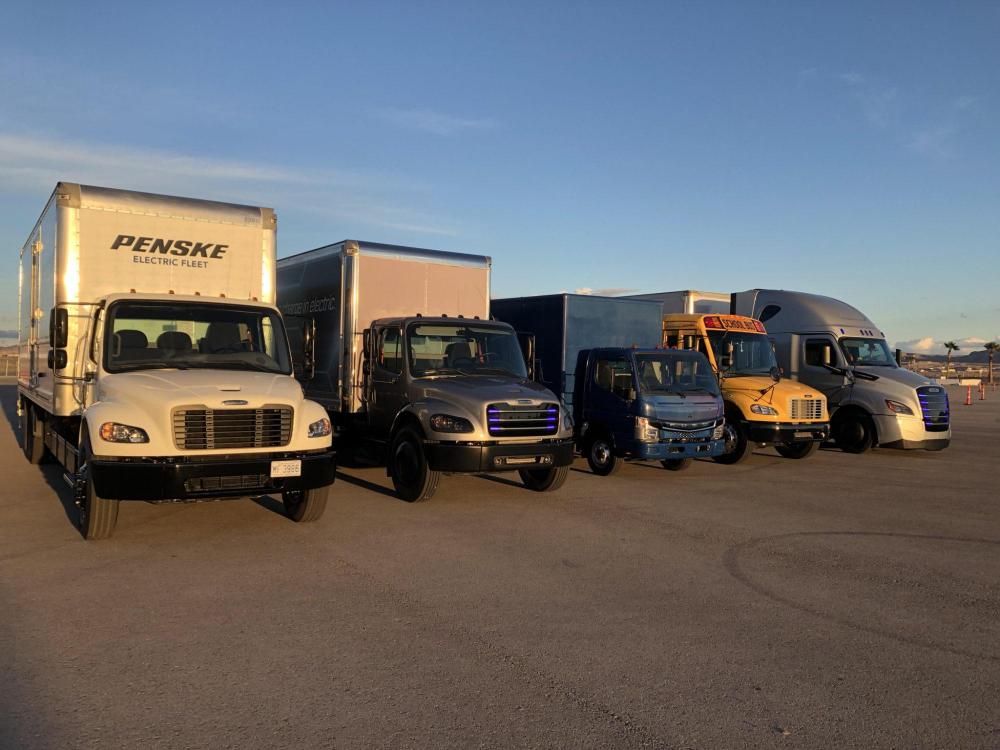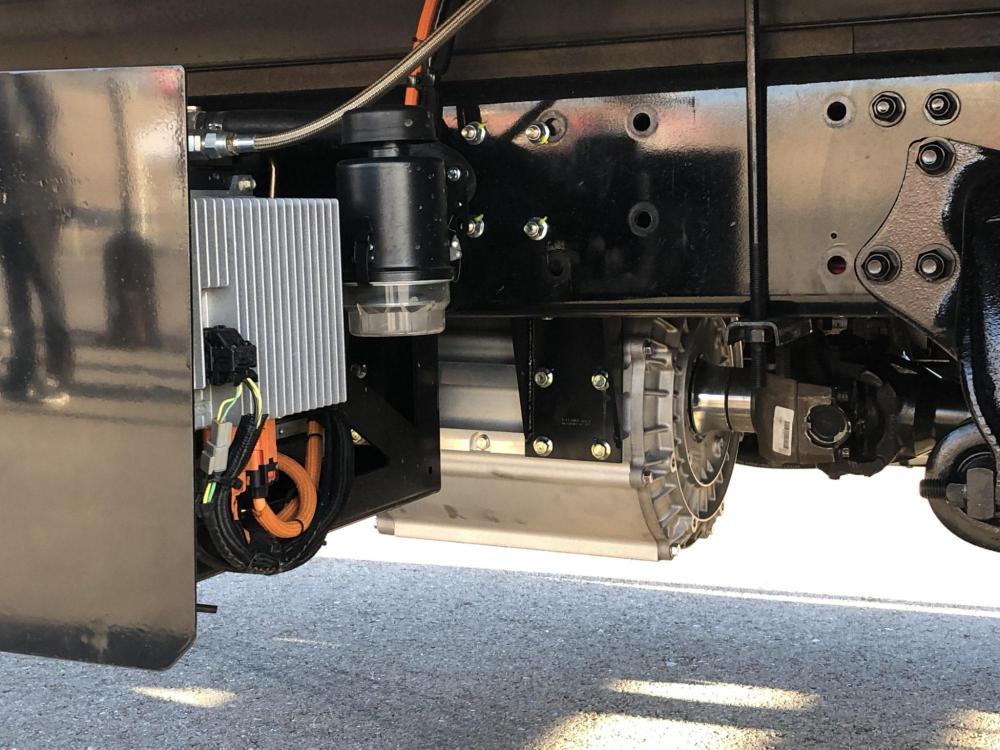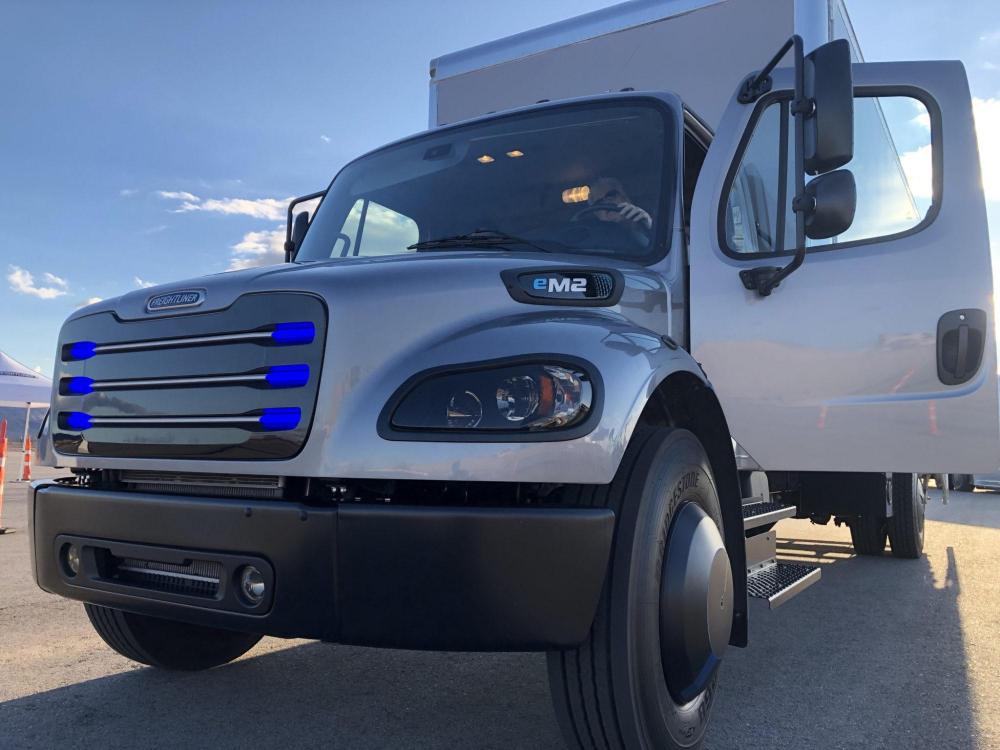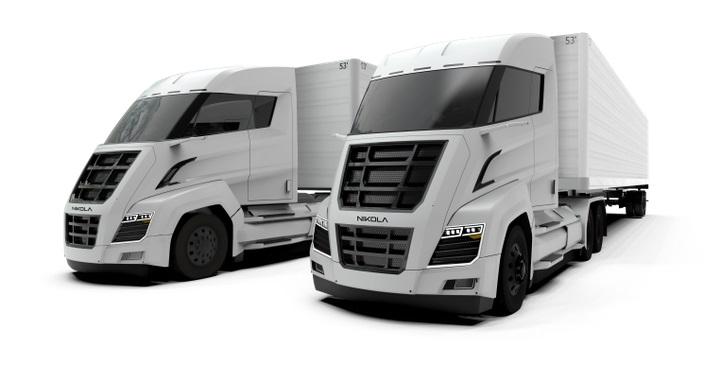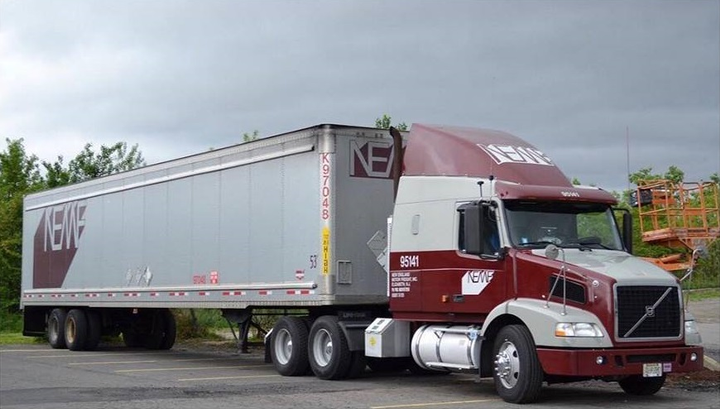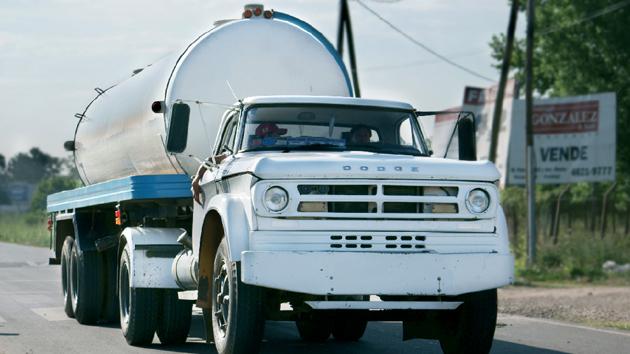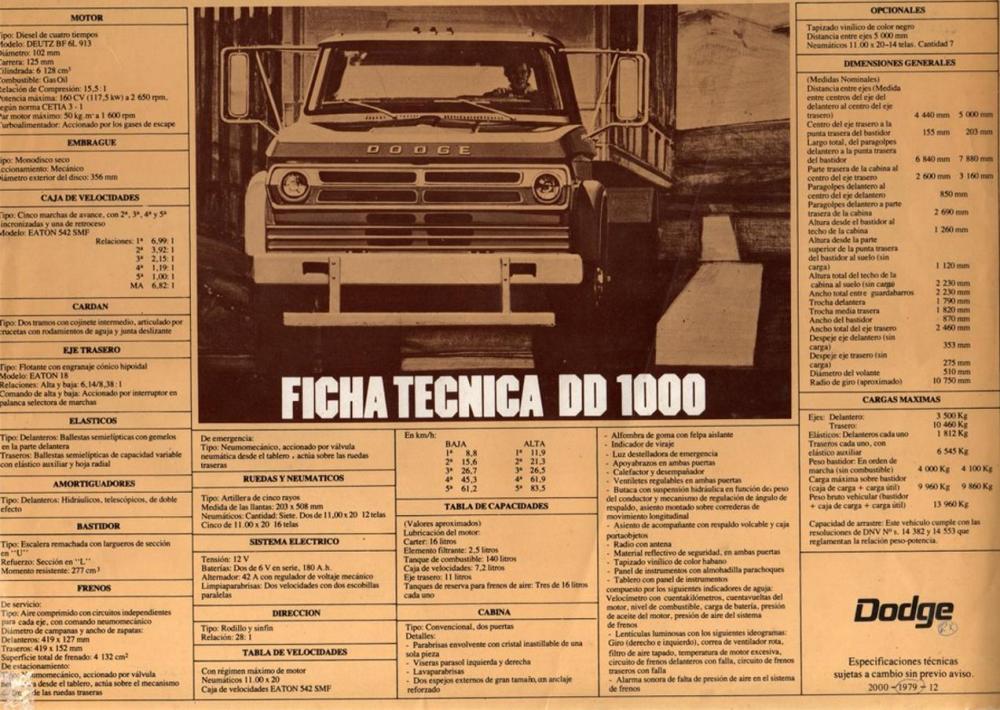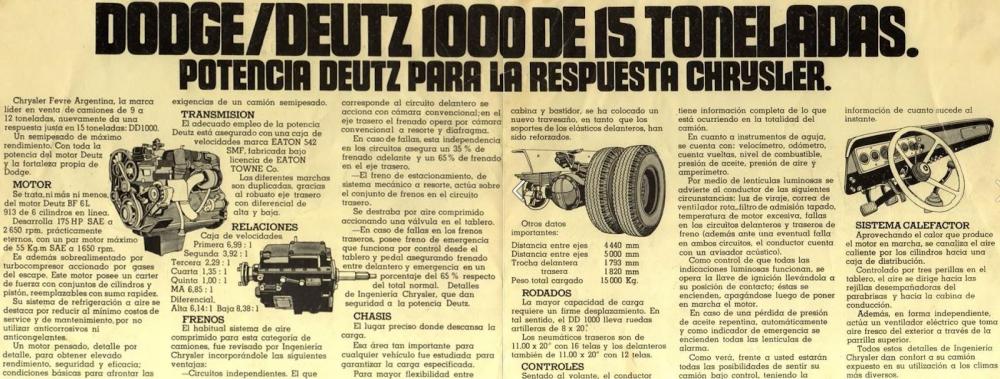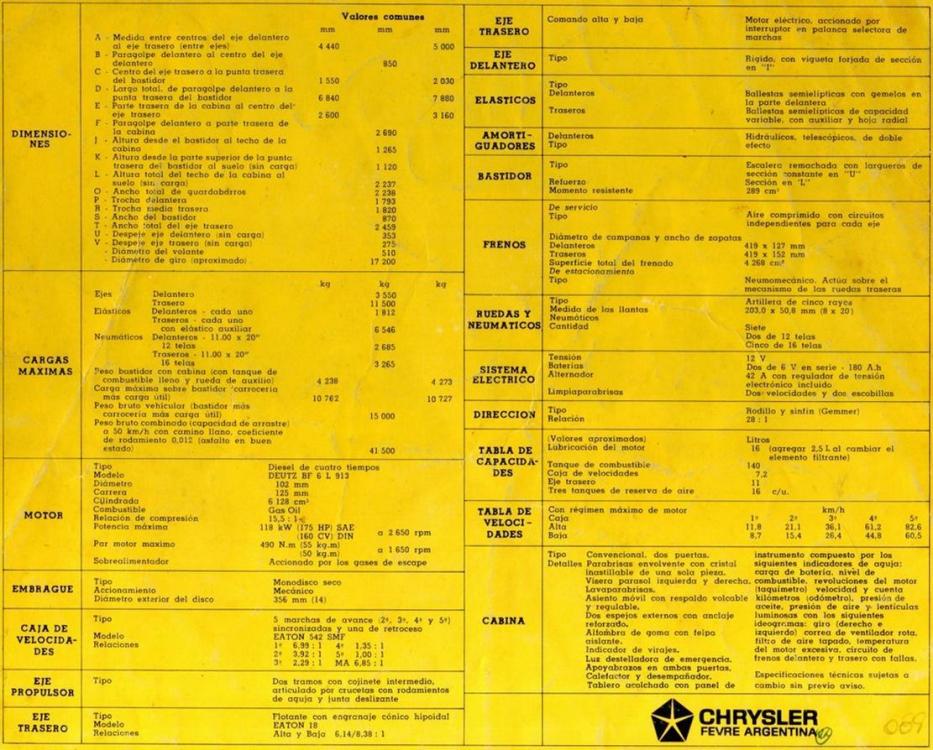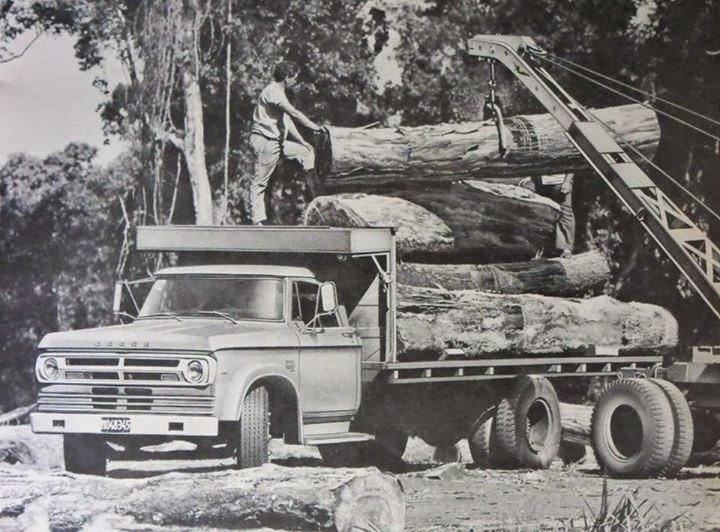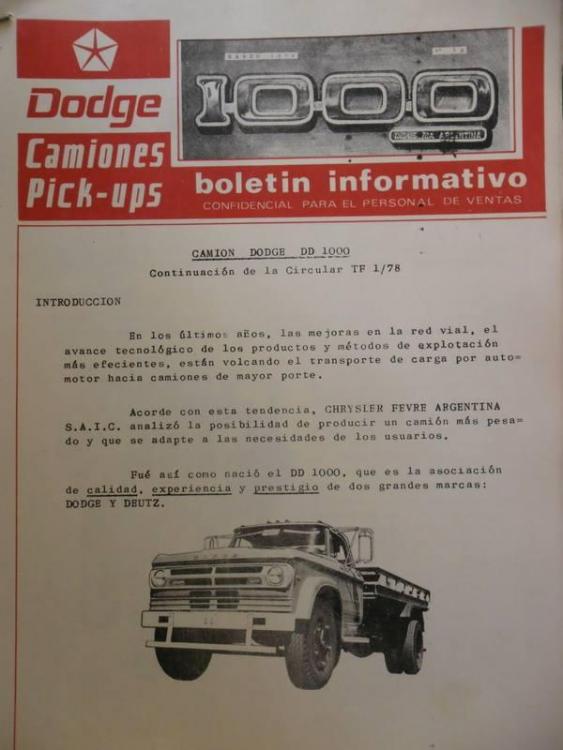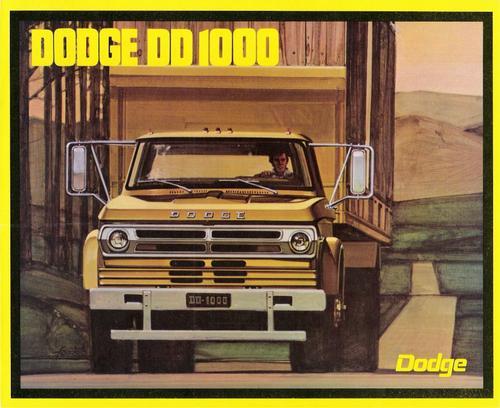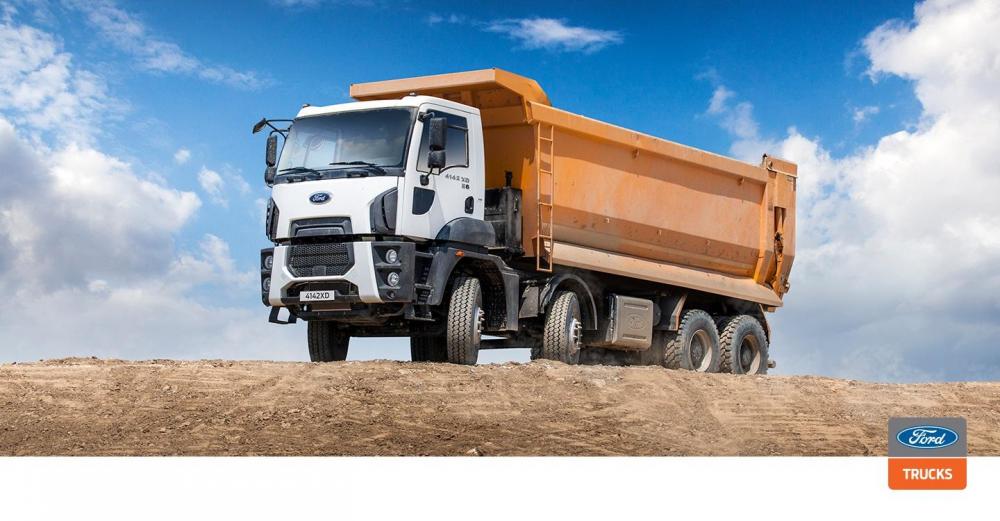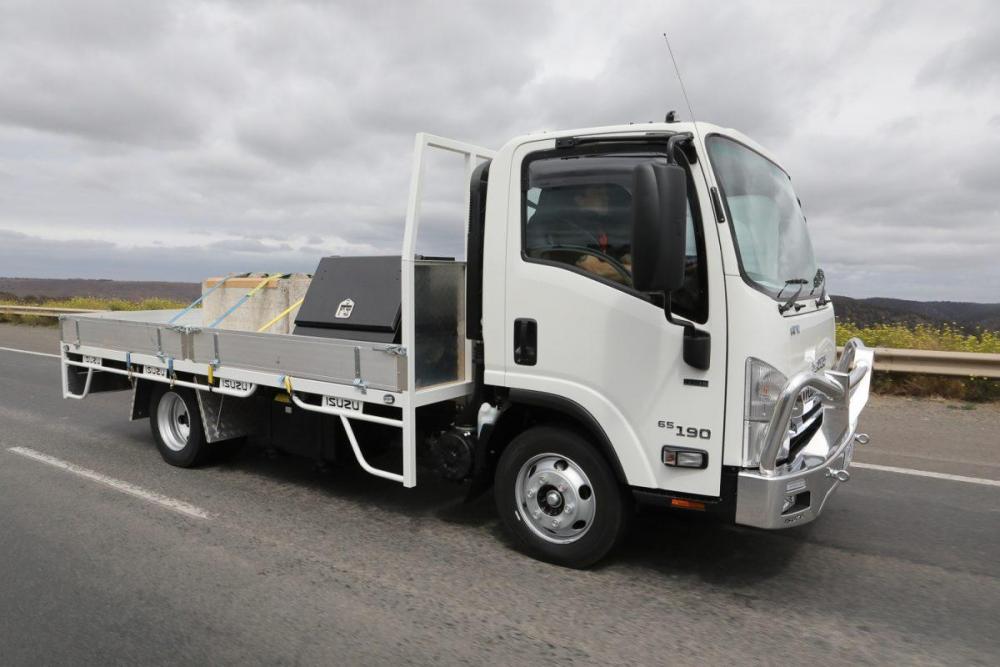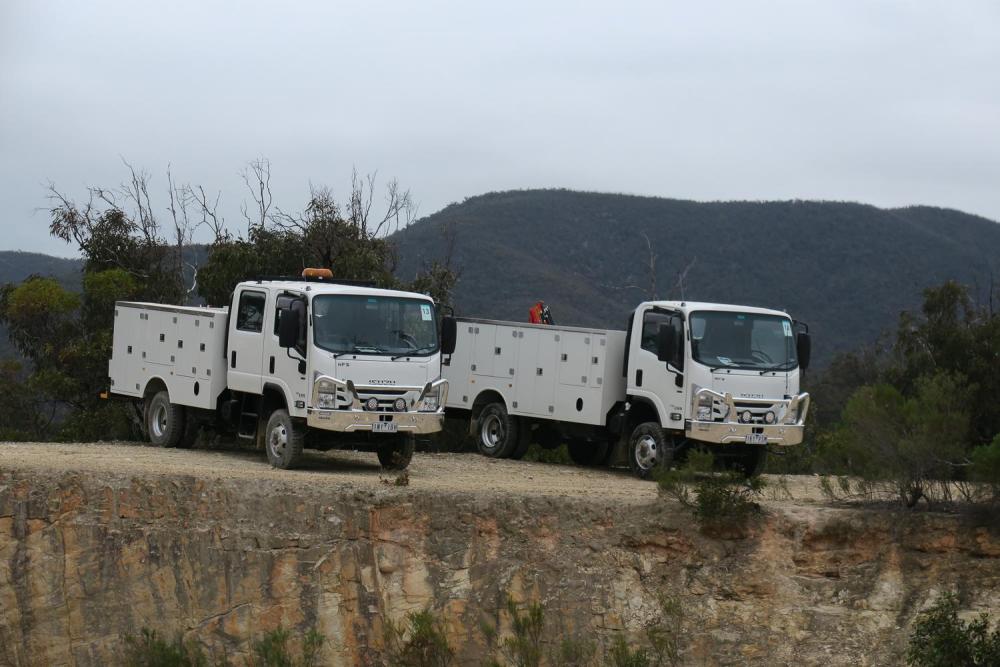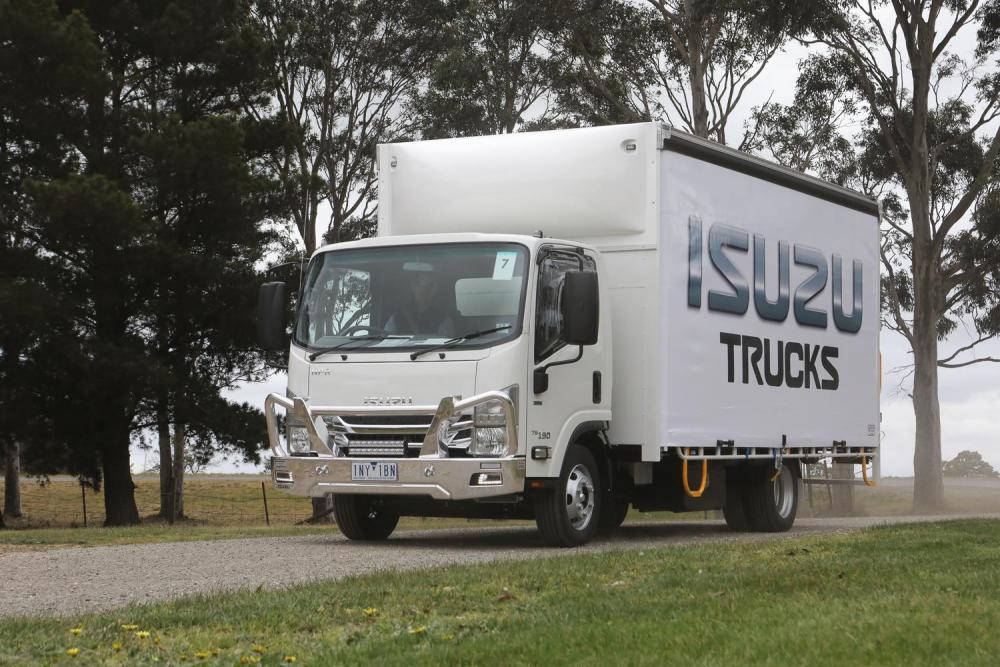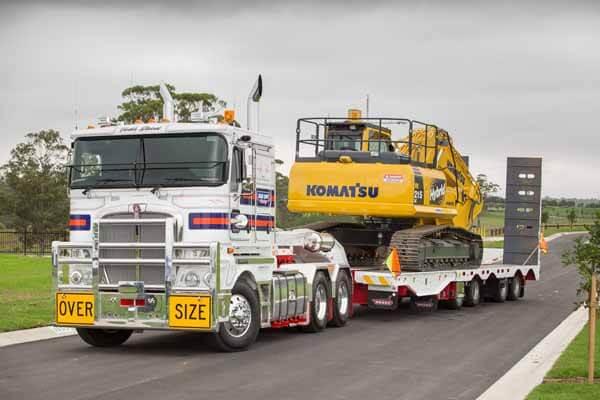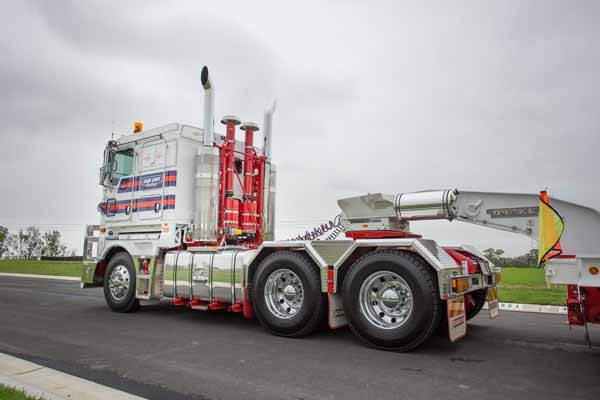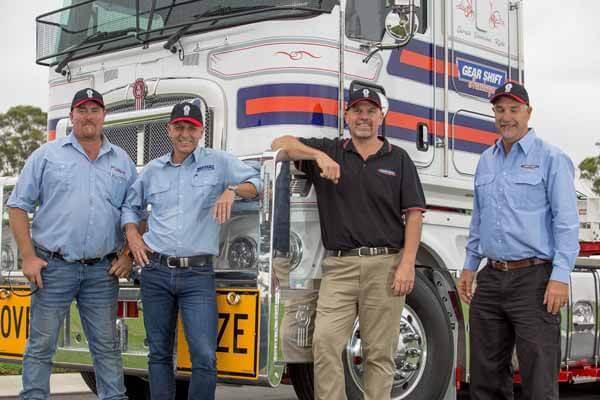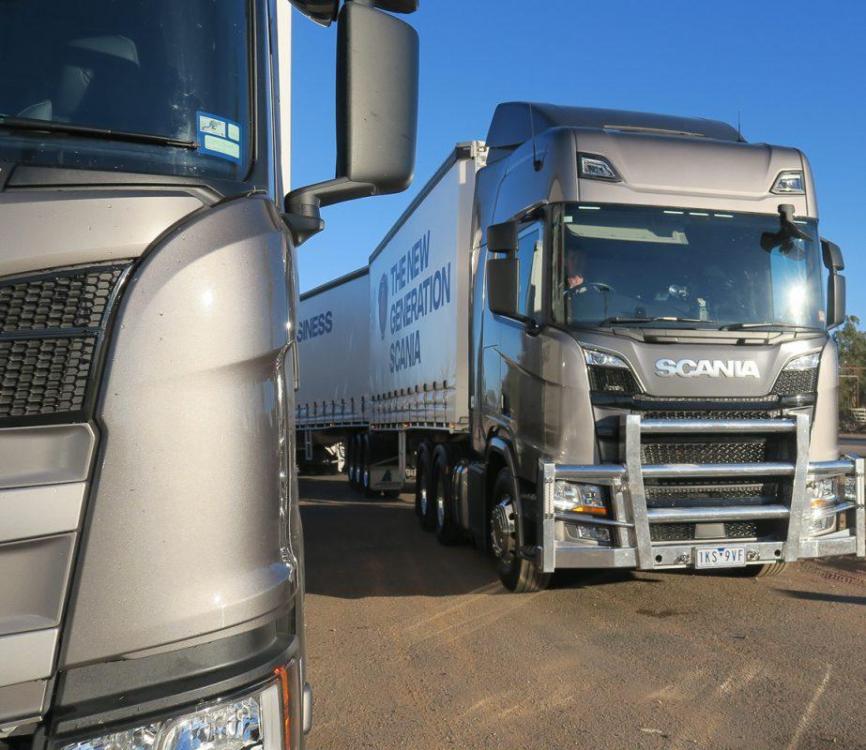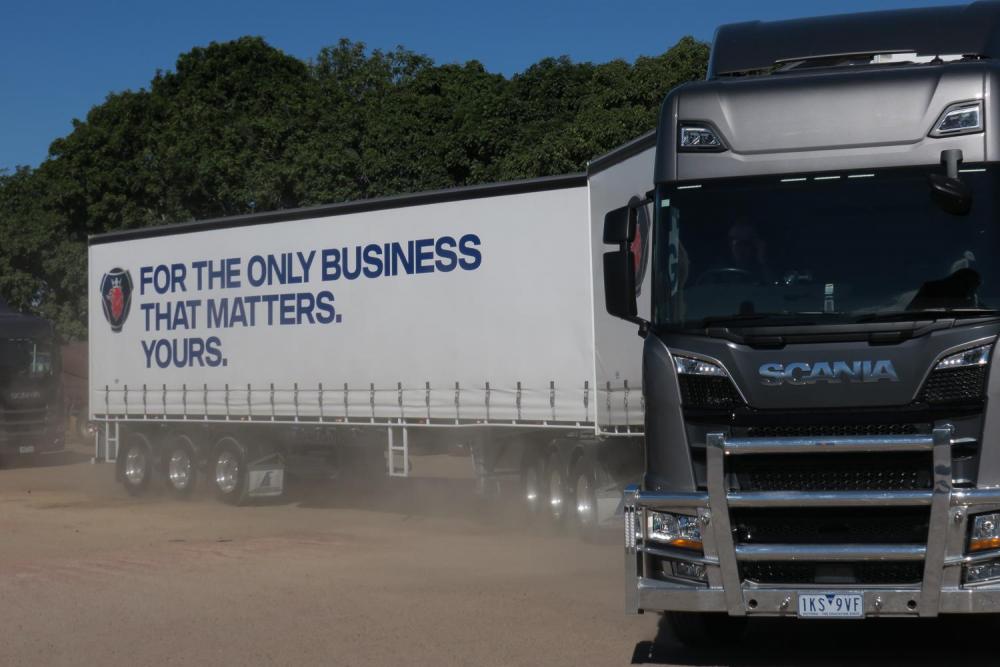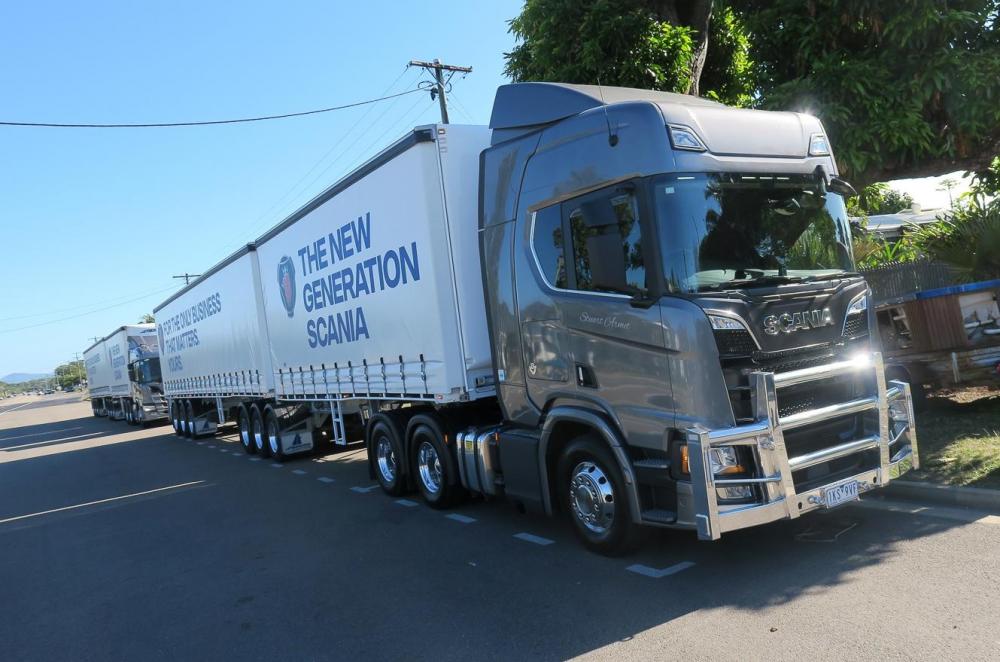
kscarbel2
Moderator-
Posts
18,546 -
Joined
-
Days Won
112
Content Type
Profiles
Forums
Gallery
Events
Blogs
BMT Wiki
Collections
Store
Everything posted by kscarbel2
-
Cummins X12 Engine Now Available for Freightliner 114SD
kscarbel2 replied to kscarbel2's topic in Trucking News
-
Cummins X12 Engine Now Available for Freightliner 114SD
kscarbel2 replied to kscarbel2's topic in Trucking News
. . -
Jim Park, Today’s Trucking / February 11, 2019 LAS VEGAS, Nevada — As trade journalists, we are exposed early to emerging technologies. In the case of battery electric vehicles, we have been writing about them for close to five years now. My first BEV test drive was in 2015, and I have driven about a dozen since then. Except for three of them, most of those trucks were “proof of concept” vehicles, that is, someone bolted a bunch electric stuff onto an existing diesel truck chassis to show it can be done. They succeeded in generating enough of a buzz and the twinkle of possibility to move the concept forward, but it’s sobering to think how far off these things really are for the folks who will eventually use them. It will still be at a least two years before medium- and heavy-duty (Class 6, 7 and 😎 battery-electric trucks are available for fleet consumption. At the risk of over-simplifying things, making light-duty electric trucks work in the real world is fairly easy. Battery capacity and weight are the big limiting factors in any electric vehicle, but weight isn’t a huge concern with courier trucks, last-mile delivery applications, or even transit and school buses. Range is commensurate battery capacity (size and weight), and since these vehicles generally run less than 150 km per day and have plenty of regenerative-braking charging opportunities or short duty cycles (school and transit buses), the battery size and weight can be limited. That’s not the case with heavier classes of truck. Daimler Trucks is just now inviting fleets to the table for serious discussions and in-fleet testing of these trucks. It’s not that Daimler is late to the game, it’s that the company has been evaluating which technologies are best suited to the market and have a real chance of succeeding. There is a lot more to medium and heavy battery-electric vehicles (BEVs) than simply replacing the diesel powertrain with a bunch of electric stuff. It should be noted that Volvo Trucks announced last year that it would have a medium-duty electric truck, the FE, available to European consumers sometime in 2019. There are also plans to bring a VNR Electric to North America by 2020. Meanwhile, Volvo will also begin testing battery-powered refuse trucks and short-haul Class 8 tractors sometime this year. Peterbilt has already begun fleet tests with a refuse truck, the Model 520EV, and a short-haul Class 8 tractor, the Model 579EV. The company also just unveiled its entrant to the battery-powered medium-duty market, the Model 220EV. It’s slated to go into fleet tests this summer. Mack says it will have a battery version of the LR refuse chassis in customer tests in 2019, and International has pledged to bring a medium-duty BEV to the game sometime this year, but we haven’t seen anything from them yet. Just before the Consumer Electronics Show opened in Las Vegas in January, Daimler Trucks introduced its Innovation Fleet of four battery electric vehicles. The fleet includes an M2 106 chassis with an electric powertrain, called the eM2. There’s an eCascadia Class 8 tractor, a Thomas Built electric school bus and a Fuso eCanter Class 4 delivery truck. The eCantor was launched last summer by Fuso (owned by Daimler) in New York City and already dozens of them are in service around the U.S. The introduction of the Innovation Fleet was accompanied by a frank discussion of the hurdles still to be overcome before wide-scale adoption and scaled-up production begins. Challenges range from the cost and weight of the batteries to the appropriate location of the charging plug and what the residual might look like on a five-year-old electric truck. Andreas Jurtzka, e-mobility lead for Daimler Trucks North America, says the OEM must know what the customers’ business is in order to design an appropriate powertrain, while considering range and payload — and of course the weight and cost of the batteries. To illustrate the point, Daimler had an eM2 at CES and Peterbilt had just unveiled its Model 220EV. According to the spec’s for both trucks provided by the companies, the battery capacity on the eM2 is more than twice that of the 220EV — 325 kWh compared to 148 kWh. That doesn’t mean one truck is better than the other, it only implies that the two trucks probably have different target applications. Having double the battery capacity suggests the eM2 will be heavier and more expensive than the 220EV. It will have a longer range, but it may suffer from payload limitations as a result of the heavier battery pack. For the pickup and delivery applications with the eM2, Daimler is looking at a range of 370 km, while the spec’s provided by Peterbilt indicate they are looking at 160-km range. And the final consideration is price. Neither Peterbilt nor Daimler talked about price, but both acknowledged that they will be expensive. There are all kinds of subsidies available in the U.S for BEVs, but few in Canada, and without some hard numbers to compare, it’s impossible to determine the return on investment. So, all that to say, when we do test drive evaluations on electric trucks, we look at them differently than we do diesels. We have a pretty good idea what to expect from an M2 106 chassis with respect to visibility, ride quality and maneuverability. None of that changed with the electric version. We also know from past experience with electric motors that they are very torquey, giving drivers a quick launch. But Daimler had two eM2 chassis in Las Vegas that day, and there were differences. One was the actual truck delivered to Penske in late December, the other was a prototype with which Daimler has been doing some internal testing. The Penske truck reportedly had three battery packs while the stock truck had just one. Performance between the two was noticeably different, but without knowing the technical differences and being unable to factor in cost and weight, it wouldn’t be fair to say the Penske truck was a better choice than the stock truck. Performance was more than adequate on both trucks, acceleration was good, regen braking performance was akin to Level 1 or 2 with a diesel engine brake, and of course both trucks were dead quiet. The eCascadia in town for the event was fully loaded, and very close to an 80,000-pound gross vehicle weighta. It had battery capacity of 550 kWh and peak output of 730 kW (978 hp). The projected range for the truck was 400 km. It too was quiet and quick, and felt very light under foot for a fully loaded five-axle vehicle. Its electric motors clearly outperformed the diesel engines I was used to during a launch and the acceleration phase. As Cascadias go, the electric version was no different from the diesel except, of course, for the near silence in the cab. Peterbilt did not have a 220EV available for test drives. Daimler and the other OEMs have a lot of evaluation and validation work ahead of them, but it looks like battery electric trucks will be on the market soon. Just don’t expect to see one in every fleet in town. They will shine in certain application but current technology will limit the markets they can serve successfully at a reasonable return for the fleets. .
-
Nikola Teases New All-Electric Truck Models Jack Roberts, Heavy Duty Trucking (HDT) / February 11, 2019 Nikola Motors exploded onto the scene three years ago, initially promising an all-electric, long-haul, tractor. Almost immediately, that mission statement was amended, detailing a hybrid hydrogen-battery electric drive system, which Nikola said would give its truck 1,000 miles of range between refueling stops. But it appears the company never gave up on its initial, proposed, all-electric truck. In a surprise tweet late last week, the company announced that at its Nikola World technology showcase in April it will announce short-haul, battery-electric versions of the Nikola Two and Nikola Tre in addition to the hydrogen-electric model. Nikola said the all-electric truck is designed for inner city delivery routes and weight-sensitive applications. However, the company stressed that it is not phasing out hydrogen drivetrains. Indeed, Nikola said it is expecting to see 50 times the number of orders for hydrogen drivetrains over electric ones – but noted that in some applications, battery-electric trucks “work great.” Details are sketchy – Twitter being what it is – but Nikola did give away some additional information on the news in a series of additional Tweets. Both trucks will be offered in 500kWh, 750kWh and 1mWh versions. And there will be an option to spec Nikola’s hydrogen-electric drivetrain instead of a battery-electric one. H2 is 5,000 lbs lighter than BEV and is cheaper for long haul applications even with H2 costs. BEV is for inner cities and non weight sensitive applications. Nikola is not phasing our hydrogen at all, we will see 50:1 more hydrogen orders but some applications BEV works great. — Nikola Motor Company (@nikolamotor) February 8, 2019 Looking specifically at the Nikola Two model, the company tweeted that it will be an 80,000 lbs. vehicle that uses 2.25 kWh per mile in most applications. The 1 MWh model has a range of 400 miles, which falls to 300 miles in cold weather, the company said. 1) BEV @ 80,000 lbs. uses ~ 2.25 kWh per mile in real weather and normal hills on routes. 1MWh gets about 400 miles. Only 90% battery is useable. In cold weather, you get 300 miles / 1Mwh. Takes 69,000 "21700" cells @ 68grams = 1MWh. 10.5k weight in cells. 20k truck weight — Nikola Motor Company (@nikolamotor) February 8, 2019 2) Fuel cell 80 kg H2 gets 7-10 miles per kg and uses same 2.25 kWh per mile as BEV. Fuel cell weight 15k -17k so about 3k – 5k pounds less than BEV. Fuel Cell can't be beat long haul and BEV is good option for short haul. World needs both. ICE is enemy, not hydrogen or BEV — Nikola Motor Company (@nikolamotor) February 8, 2019 The Nikola Tre previously was announced as a fully electric hydrogen-powered day cab tractor aimed at markets in Europe. Nikola unveiled its first hydrogen-electric prototype, the Nikola One, in December 2016. The official word debut for the Nikola Two and Nikola Tre is stated for the Nikola World technology fair in Scottsdale, Arizona, April 16 and 17, 2019. .
-
Heavy Duty Trucking (HDT) / February 11, 2019 Volvo Trucks has added an ergonomic workstation option for its VNL760, 740 and VNX 740 models, offering a flexible working environment for drivers while out on the road. It features ergonomic advancements that allow drivers to enjoy the comforts of home while on the road. The workstation transforms from a sitting area and table for relaxing, eating and catching up on work, then lowers as a base for seating cushions that unfold into a bed. Additional enhancements include an angled table for easy seating; a 103-degree cushion seat angle to improve seating comfort; and connected cushions that can be easily secured to allow for adequate rest. The workstation is designed to improve productivity, comfort and overall convenience for drivers in the cab and it is available for order as an upgrade. With various configuration possibilities, solo drivers can leave the table set-up and sleep in the top bunk, while team drivers may choose to collapse the table for access to both bunk beds. The workstation also allows space for storage inside the bottom bunk bases. The workstation option was previously available on the VNL 670 model. “This advanced workstation is the latest example of the emphasis Volvo Trucks has placed on enhancing driver comfort and driver productivity,” said Allison Athey, product marketing manager at Volvo Trucks North America. “The ability to create an exceptional all-in-one living space and working environment is essential to attracting and keeping drivers.” .
-
Matt Cole, Commercial Carrier Journal (CCJ) / February 11, 2019 Nearly 15,000 trucks manufactured by Paccar, Daimler and Autocar are being recalled for various defects, according to recent documents from the National Highway Traffic Safety Administration. Paccar is recalling approximately 6,857 Kenworth and Peterbilt tractors for an issue with the seat belt assemblies. The company says seat belt buckle assemblies in the affected trucks may have been glued and not sewn during manufacturing, possibly causing the assembly to come apart in the event of a crash. Affected trucks include model year 2018 Kenworth T680 and T880, and model year 2018 Peterbilt 567 and 579. Paccar is notifying affected truck owners, and dealers will replace the seat belt buckle assembles that weren’t sewn for free. Owners can contact Paccar customer service at 1-918-259-3258 with recall numbers 18KWG and 18PBD. NHTSA’s recall number is 18V-870. Daimler’s recall affects approximately 6,795 Freightliner and Western Star tractors and chassis equipped with certain Eaton Electronic Clutch Actuation (ECA) heavy-duty truck clutches. The company says an internal component in the clutch assemblies could fail, possibly resulting in unintended vehicle movement. Affected truck models include: 2018-2019 Freightliner 108SD 2018-2019 Freightliner 114SD 2018-2019 Freightliner 122SD 2018-2019 Freightliner Business Class M2 2018-2019 Freightliner Cascadia 2018-2019 Western Star 4700 2018-2019 Western Star 4900 2018-2019 Western Star 5700 Daimler will notify affected truck owners, and dealers will update the software and repair any physical components for free. Owners can contact DTNA customer service at 1-800-547-0712 with recall number FL-803. NHTSA’s recall number is 18V-903. Autocar also announced it is recalling approximately 1,003 model year 2019 Xpeditor trucks due to an issue where the universal joint strap bolts at the transmission output yoke may not be properly tightened. If these bolts are loose, the strap may disconnect from the truck, and the drive shaft could detach. Autocar has notified owners, and dealers will properly tighten the bolts for free. Owners can contact Autocar customer service at 1-888-218-3611 or 1-877-973-3486 with recall number ACX-1901. NHTSA’s recall number is 18V-889.
-
Truck News / February 11, 2019 OTTAWA, Ontario – Changes to the Heavy Truck Weight and Dimension Limits for Interprovincial Operations in Canada pave the way for truckers to use wide-base single tires at the same weight limits as duals right across Canada. The decision was made during the meeting of the Council of Ministers Responsible for Transportation and Highway Safety in late January. “We are grateful for the leadership shown by the First Ministers, Council of Ministers Responsible for Transportation and Highway Safety and the provincial and territorial government representatives of the Task Force on Vehicle Weights and Dimensions Policy for moving forward on this issue so that the trucking industry can take advantage of this progressive equipment technology under the MOU umbrella,” said Canadian Trucking Alliance (CTA) senior vice-president of policy, Geoff Wood. The CTA says the next step is for the provinces and territories to amend their regulations to reflect the recent changes, and in the interim, to offer permits to facilitate the movement of single tire-equipped vehicles. “The outcome of this policy decision which also saw an all-hands-on-deck effort from the provincial trucking associations in the Alliance strikes a good balance between road infrastructure preservation and productivity, safety and environmental considerations. It also levels the playing field with respect to Canadian and U.S. fleets in their tire spec’ing options. The ultimate goal of this effort now and all MoU updates is to have all jurisdictions adopt the MOU changes in their regulations as quickly as individual regulatory/legislative timetables permit,” added Wood. The MOU can be read here.
-
Ram intros 'new generation' of chassis cab work trucks Trailer-Body Builders / February 11, 2019 Ram Trucks says its newly introduced 2019 Ram 3500, 4500 and 5500 Chassis Cabs will usher in a “new generation of work trucks” with “never-before-offered comfort and technology.” The cab-and-chassis trucks, designed for “unforgiving” duty cycles, efficiency and upfitter friendliness, boast a segment-leading towing capacity up to 35,220 pounds, the highest Gross Combined Weight Rating of 43,000 lbs and payload up to 12,510 lbs. The new line of halo-capability trucks also offers an optional comfort level with the new Limited model, exclusive in-cab features, and all the latest driver-assistance technology, including adaptive cruise control, Forward Collision Warning, Automatic Emergency Braking (AEB), and AEB with trailer brakes on all trim levels. “Ram Chassis Cab operators work their trucks at maximum capability in the harshest drive cycles every day,” said Reid Bigland, head of Ram Brand for FCA. “By offering 35,220 pounds of towing capacity, 12,510 pounds of payload and a Gross Combined Weight Rating of 43,000 pounds, our 2019 Ram Chassis Cabs take segment leadership in areas most important to customers and upfitters alike. “With the Chassis Cab Limited, we’ve also created something the segment has never seen, surrounding owners in premium materials and technology with the highest quality interiors, active safety systems, and of course, our award-winning Uconnect technology.” The standard Ram Chassis Cab engine is a 6.4-liter HEMI V8 with up to 410 horsepower and 429 pound-feet of torque. The 3500 employs exclusive Fuel Saver Technology (FST) cylinder deactivation for increasing fuel economy. When paired with the optional Aisin AS66RC six-speed automatic transmission with Power Take-Off (PTO), FST functions under light load while in stationary PTO mode to reduce fuel consumption. In the Ram 4500 and 5500 Chassis Cab, the 6.4-liter HEMI V8, paired with the AS66RC electronically controlled six-speed automatic transmission with optional PTO capability delivers 370 hp and 429 lb-ft of torque. A revised Cummins 6.7-liter inline-six turbo diesel is optional on all three models. Paired with the Aisin AS69RC electronically controlled six-speed automatic transmission with optional PTO capability, the Cummins engine delivers 360 horsepower and the highest available torque in Class 4 and 5 at 800 lb-ft. Changes to the Cummins engine include a cylinder block made from compacted graphite iron that is stronger and better able to dampen vibrations. A new cast-iron cylinder head builds on the new block with changes that include new exhaust valves and springs, and new rocker arms driven by a hollow camshaft, contributing to the weight savings. The Chassis Cab trucks come in four industry-standard frame lengths measured in inches from the cab to the rear axle (CA): CA 60, CA 84, CA 108 and CA 120. Frame rail width also follows industry guidelines at 34-inch spacing. All 2019 frames are built with up to 97% high-strength steel and eight separate cross members. With upfits in mind, Ram Chassis Cab rear frame sections feature a C-channel design with flat mounting surface—zero component interference above the rails, making upfit and accessory design/installation easy, cost-effective and reliable. Additionally, pre-drilled holes are designed throughout the structure to route upfit lines or mount hardware related to the upfit. Light-weighting efforts include an aluminum hood, which contributes to an overall weight reduction of 120 pounds. The cab back panel area is clear for ease of upfit. Ram Engineering provides instructions to create a pass-through cab for emergency vehicles. The 2019 Ram Chassis Cab lineup uses tuned powertrain mounts and C-pillar body hydromounts to reduce NVH and improve ride quality. Within the mounts, the viscosity of the fluid and the rubber itself have been tuned to Gross Vehicle Weight (GVW) and payload capabilities, enhancing isolation regardless of load or tow capacity. A best-in-class Vehicle System Interface Module (VSIM) is capable of communicating between aftermarket modules and various factory control modules. The VSIM upfitter interface module features more than 70 inputs and outputs, including lighting controls, door position, and throttle and transmission position. Ram expects its 2019 Chassis Cabs, built at the Saltillo truck assembly plant in Coahuila, Mexico, to be available in the second quarter of 2019.
-
NEMF and 10 related subsidiaries declare bankruptcy John Schulz, Logistics Management / February 11, 2019 It is another sad day in the trucking industry as another storied, unionized, less-than-truckload (LTL) carrier has gone under and taking tons of capacity away from shippers in the Northeast. In a financial development that shocked the trucking industry, 101-year-old New England Motor Freight and 10 related subsidiaries (including truckload giant Eastern Freightways) voluntarily filed for relief under Chapter 11 of the Bankruptcy Code in the U.S. Bankruptcy Court for the District of New Jersey in Newark on February 11. Privately held NEMF, which competes mostly in the high-cost Northeast region, ranked last year as the 17th-largest LTL carrier in the country with revenue of just over $400 million. As a private company, NEMF did not release profit or loss numbers. NEMF said it “intends to use these proceedings to facilitate an orderly wind-down of its operations.” NEMF was a unionized carrier, mostly covered by the International Association of Machinists and Aerospace Workers, whereas nearly all the other LTL unionized bankruptcies involved Teamsters-related companies. NEMF’s cessation underscored the brutal nature of the thin-margin trucking industry. NEMF’s exit leaves only a handful of Northeast regional LTL carriers with significant capacity – YRC unit New Penn, Pitt Ohio, A. Duie Pyle and Ward Trucking, among them. In an interview with LM last month, Myron P. Mike Shevell, chairman of the Shevell Group, hinted at changes when he described his freight demand as “very light right now.” But that is somewhat a normal condition for January in trucking. “The LTL market is changing dramatically with computerization and different shippers changing modes,” the 83-year-old Shevell said. “There’s more shippers going to warehousing and shipping direct via crossdock or from the manufacturing point. That’s all changing.” In that interview, Shevell warned, “Nobody can afford the cost of equipment sitting idle and people taking advantage of that. There’s a lot of hiccups. There are a lot of problems. There’s going to be a point where you’ll just have to wait and see.” Vincent Colistra, senior managing director with Phoenix Management Services, and chief restructuring officer said in a statement, “We have worked hard to explore options for New England Motor Freight, but the macro-economic factors confronting this industry are significant.” Phoenix is serving as NEMF’s restructuring advisor through Vincent Colistra as the CRO. Colistra declined comment when contacted by LM. NEMF said after two years of losses, and with “continuing and unsustainable rises in overhead” as well as a severe industry shortage of drivers, it concluded that NEMF “has no choice but to proceed with an orderly wind-down of operations” in a Chapter 11 proceeding. Knowledgeable observers of the LTL industry said NEMF’s reliance on a few large big box retailers left it vulnerable to rate cutting in order to stay afloat. “I am not that surprised,” Satish Jindel, principal of SJ Consulting, which closely tracks the LTL sector, told LM. He called it a “sad day” in the trucking industry as one of the industry’s grand old names was calling it quits. “Mike Shevell built this company from the ground up,” Jindel said of NEMF’s chairman. “My heart goes out to him.” Jindel said he didn’t think NEMF’s financial difficulties were that serious but “apparently they were,” Jindel added. Jindel took polite issue with NEMF citing “macroeconomic factors” in the LTL industry as reason for its demise. “While they state the macroeconomic factors are significant, I believe they are not being open with what caused this problem,” Jindel said. “It is not the macroeconomic problem in the industry.” Jindel, whose company compiles the annual Top 50 trucking lists for LM, disclosed that this year’s listing will show nearly all the top carriers have posted year over year revenue increases of 10% to 12%. “If you got that revenue, and didn’t just your cost your freight properly, shame on you,” Jindel explained. Privately, industry insiders said the challenge NEMF faced is what happens when it became too reliant on one or two large retail customers and must accept rate decreases in order to keep its trucks filled. “If you let one customer get too big and that customer dictates what you have to do, that’s bad,” one industry source said. “It’s a Catch-22. You can’t say no, but if you say yes, you find yourself digging a hole.” NEMF said only “upon the recommendation of its advisors,” it determined that a Chapter 11 proceeding was the “best mechanism to maximize the value of its assets for the benefit of its employees” and various creditor constituencies. Besides Shevell and other NEMF employees, the biggest losers are going to be the shippers in the Northeast. They face an ever-dwindling supply of reliable, large LTL carriers. And with NEMF out of the picture, Jindel said those Northeast shippers can expect double-digit rate increases as capacity tightens. Overall, the Shevell Group companies ranked as the 70th-largest trucking conglomerate in the country. Its units ran more than 1,550 company trucks and nearly 4,000 trailers. The timing could favor YRC Worldwide. Not only does YRC own New Penn, one of the remaining large Northeast carriers, but it has a contract coming up covering 24,000 Teamsters that expires at the end of March. “Here’s another union company folding—that’s not good for the Teamsters,” Jindel noted.
-
New England Motor Freight Files for Bankruptcy Heavy Duty Trucking (HDT) / February 11, 2019 LTL carrier New England Motor Freight and its subsidiaries have voluntarily filed for Chapter 11 bankruptcy in New Jersey, intending to facilitate an orderly wind down of its operations. The Elizabeth, New Jersey-based company had fallen on hard times, recording losses in consecutive years as well as “unsustainable rises in overhead,” according to Vincent Colistra, a senior managing director for Phoenix Management Services and chief restructuring officer for the company. Colistra also placed blame on a severe shortage of available drivers in the trucking industry. Just a week prior to filing, NEMF had implemented a 5.4% general rate increase saying that it was faced with increased costs associated with regulatory mandates, insurance premiums, new equipment and technology advancements. As a result, the company determined that Chapter 11 would be the best way to maximize the value of its assets for the benefit of its employees and various creditor constituencies. “We have worked hard to explore options for New England Motor Freight, but the macro-economic factors confronting this industry are significant,” said Colistra. “We have concluded that the Company has no choice but to proceed with an orderly wind-down of operations in a Chapter 11 proceeding.” .
-
Neil Abt, Fleet Owner / February 10, 2019 Orders for new trucks dropped significantly in January, but the overall market remains healthy, according to two industry research firms. FTR said preliminary North American Class 8 orders for January were 15,600 units, the lowest since October 2016. That figure was 26% below the previous month and down 67% from January 2018. The report said the low total was not unexpected, as the great majority of fleets already have all their orders in for 2019. Class 8 orders for the past 12 months have now totaled 402,000 units, and backlogs remain about 70% above year-ago levels. "There were record breaking orders placed last July and August, and this is the payback for that volume,” said Don Ake, FTR vice president of commercial vehicles. "Even with the weak January numbers, over 330,000 trucks have been ordered in the last nine months, so demand for trucks in 2019 remains strong." He added: “the fundamentals of the economy and freight growth remain solid, so there is no reason to panic." In a separate report, another industry analyst said the industry booked 15,800 units in January, down 26% from December and 68% from year-ago January. "We view this January’s order softness as having more to do with pulled-forward orders and a very large Class 8 backlog than with the current supply-demand balance. Softening freight growth and strong Class 8 capacity additions suggest that the supply-demand balance will become a story in 2019, but January seems a premature start to that tale,” he said. The report also said Classes 5-8 orders were 23,400 for the month. “While up sequentially, January’s orders had the ignominy of being compared to one of the best order months in history, January 2018: Classes 5-7 net orders fell 24% year-over-year, the first negative comparison in 16 months,” he said.
-
Those Argentine Dodge DD-1000’s - The last of the kind
kscarbel2 replied to kscarbel2's topic in Other Truck Makes
Front axle capacity 3,500kg / 7,716 lb Rear axle capacity 10,460 kg / 23,060 lb Gross Vehicle Weight (Mass) 13,960 kg / 30,777 lb -
Those Argentine Dodge DD-1000’s - The last of the kind
kscarbel2 replied to kscarbel2's topic in Other Truck Makes
I agree with you that, since they were building the later 3rd generation D-Series cab in Mexico, Argentina with smaller volumes (than Chrysler Mexico) built the older 1st/2nd generation D-Series cab. They didn't have two sets of tooling. -
Those Argentine Dodge DD-1000’s - The last of the kind
kscarbel2 replied to kscarbel2's topic in Other Truck Makes
. . -
Those Argentine Dodge DD-1000’s - The last of the kind
kscarbel2 posted a topic in Other Truck Makes
Planeta Camion In 1960, the first national Chryslers began to be manufactured in Argentina. These were the D-400 trucks equipped with locally produced engines and gearboxes. In 1978, Chrysler makes its last effort to try to adapt to a market that demanded increasingly powerful trucks. The old formula of the Perkins diesel engine no longer worked, and Chrysler decided to follow the new trend of offering turbocharged diesel engines. At that time, the only engine option in Argentina was the German Deutz engine, thus the Dodge DD-1000 was born. It’s components consisted of a rubber floor mat with insulation, turns signals, emergency flasher light, armrests on both doors, heater and defroster, adjustable vent windows on both doors, a hydraulically-suspended driver’s seat, radio, vinyl upholstery and basic instrumentation. The DD-1000 was produced from 1978 to 1980. On May 5, 1980, the purchase of Chrysler-Fevre materialized, resulting in Volkswagen Argentina. As a result, the Dodge truck line was discontinued. Dodge DD-1000 / Specifications Chassis: riveted ladder with "U" section stringers. Reinforcement: "L" section. Bodywork: truck on frame, two-door Engine: Deutz BF6L913, lateral camshaft controlled by gears. Cycle: Diesel 4-stroke, valves at the head Feeding: turbocharged, turbo-cooled. Cylinders: 6 in line. Displacement (cm3): 6128 Diameter x Stroke (mm): 102 x 125. Power (HP-SAE): 175 to 2,650 rpm Torque: 50 Kgm at 1,600 rpm Compression ratio: 18: 1. Fuel system: direct injection Injector pump: commanded by gears to the camshaft. Transmission: 4 × 2 to the rear wheels by tubular cardan. Clutch: Mechanically driven dry monodisk, diameter 330mm (13 "). Gearbox: EATON 542 SMF Speeds: 5 forward (synchronized from 2nd to 5th), and 1 of recoil. Rear axle: floating with hypoidal conical gear. Capacity: 11460 Kg. Differential: Eaton 18, 2-speed electro-pneumatic drive. Ratio: 6.14 / 8.38. Front suspension: semi-elliptic leaf springs with binoculars, double-acting telescopic hydraulic shock absorbers. Rear suspension: semi-elliptic springs of variable capacity with auxiliary load and radial blade. Brakes: Air, independent circuit for each axis, drum in the 4 masses by "S" cams, rear with self-adjustable "guitars". Parking brake: Pneumatic drive by valve from the board. Direction: Screw and endless, semi-reversible. Optional: Hydraulically assisted. Tires: 5-spoke gunners, 8J x 20 ". Tires: 11.00 × 20 ". Gas-Oil tank: 140 liters. PBC (tow cap) at 50 km / h: 41500 Between axes (mm): 4440/5000 . -
https://www.bigmacktrucks.com/topic/30848-bigland-takes-over-as-president-ceo-of-ram-truck-brand/?tab=comments#comment-178533
-
Never in the history of commercial trucks has a vehicle produced in such small numbers enjoyed so much popularity.
-
Ford Trucks International / Sharing The Load It takes strength to succeed in construction. And Ford Trucks has what it takes. The Ford Trucks Construction Series. Engineered for the world's toughest driving conditions. .
-
Maxidyne gearing
kscarbel2 replied to james j neiweem's topic in Antique and Classic Mack Trucks General Discussion
Jim, we offered just such a Maxitorque transmission for those who wanted it with the Maxidyne high-torque rise powertrain.....the 7-speed TRDLG1070. -
Note the use of Chinese Kuka robotics. .
-
Diesel News Australia / February 2019 There seems to be no stopping the Isuzu bandwagon, as the company prepares to celebrate 30 years as the top selling brand in Australia, it just keeps pushing further ahead. Diesel News checks out the new N Series range from the Japanese truck maker. A truck brand doesn’t end up being the dominant brand in a truck market for a period as long as 30 years without doing quite a bit right. In the case of Isuzu, the company is constantly pushing itself to keep ahead of the curve and challenges competitors to keep up. There is also an efficient system for channeling the feedback from the truck buyer on the ground back to the decision makers specifying the next iteration of a particular model. Knowing what the customer wants and delivering it are vital if you want to stay number one. This introduction of a renewed N Series range of light duty models illustrates these points very well. Innovations keep Isuzu ahead of the game and adjustments have been made to satisfy customer needs. There’s also been some consideration of the comfort of those customers with the introduction of an independent front suspension on some of the NNR models at the lighter end of the range. These are the trucks which buyers are often moving up to from cars or utes and the IFS provides the kind of ride quality which could be described as car-like. Another car-like feature is the introduction of two pedal operation on the NPS 4×4 models in the new range. The automated manual transmission (AMT) has been calibrated to take the grief out of gear changing in difficult conditions where four wheel drive is needed. As is common in just about every new truck launch these days, the audio visual entertainment system gets an upgrade, bigger, with a new operating system and many more features. With their competitors all running modern entertainment systems, Isuzu just go one step further. On the engine front, the power and torque available continue to creep up, but the complexity actually goes down. Improvement to the engine’s design means the 5.2 litre 4HK1 engine no longer needs a diesel particulate filter, which can be problematic during the regeneration cycle. The diesel particulate filter (DPF) has been replaced by a maintenance-free diesel oxidisation catalyst but still meets Euro-5 emission limits. “We are always looking to develop and implement the most appropriate technology to empower Australian businesses to improve both operational efficiency and functionality,” says Phil Taylor, Director and CEO at Isuzu Australia. “We believe we are continuing to achieve that goal for our customers. Isuzu continues to have the most comprehensive truck range on the market in Australia today.” .
-
Power Torque Magazine / February 2019 There’s something very special for any fleet when a new truck arrives, and PowerTorque was privileged to join in the celebrations as Sydney-based Gear Shift Haulage commissioned its latest combination with a special tribute. Formed in 2013 by managing director Lee Fahey as an offshoot of a civil construction business, Gear Shift continues to become a dominant player in heavy earthmoving equipment transport from its company base in Ingleburn, south-west of Sydney. Drawing on the success, experience and infrastructure already in place, Gear Shift Haulage transports heavy machinery and plant to all areas of the Sydney basin, as well as regionally within NSW and interstate. At any time, the scope of work for Gear Shift may span hauling small equipment such as remote trench rollers, up to 45 tonne compactors, dump trucks or crushers. Currently the workload is split, with 85 percent attributed to external customer requirements and the remaining 15 percent catering for internal company movements. Kyle Bunning is the transport manager for Gear Shift Haulage and explains the company’s business philosophy. “The machinery movement business can be extremely delicate, and you need to be on your A-game all the time,” he said. “Service is a big thing. Realistically, customers do not necessarily remember all those little jobs you managed to complete on their behalf at the last minute in order to keep their jobs on track. They do, however, remember if a truck doesn’t turn up, or you might have previously said that it was not possible to handle a specific job, so we are extremely customer focused. “We find now that a lot of our clients are searching us out to do work for them, even if they traditionally have ties to other transport carriers. We don’t actively chase other company’s clients as that is not the way that we operate. However, if they come to us and request a job because another service provider can’t get a job done for them, we’ll try to help them out”. Prior to the early part of 2018, Kyle handled all the operational planning and allocations himself. It was at this stage that the decision was made to employ Rick Sookee, to take responsibility for allocation. “My phone never stopped ringing, ” said Kyle. In another bid to streamline operations, Gear Shift implemented a single email system for contact, using Excel Online. This informs several staff members of the whole process of booking jobs, relieving a lot of the burden from any single staff member. “It helps share the operational load more evenly and keeps all concerned well and truly in the loop, in real time,” Kyle said. “This game can also be a bit hit-and-miss with workloads. One day you can be flat out and be dreaming of another couple of trucks available in the fleet, and the next there is the risk that they might all be sitting in the yard with no work, so we have to carefully plan our equipment purchases”. The latest prime mover to join the Gear Shift fleet is a Kenworth K200, bringing the total number of trucks operated by the company to six. In addition to the new flat roof K200, the fleet comprises two Volvos in the form of one FM and One FH, together with a K200 Aerodyne and a Kenworth T359 tilt tray. Finally, working on back-up duties predominantly in the yard is an older K104 model. The fleet also comprises three trailers − two deck-widening, steerable quads, one 3 x 8 full widener and a bogie axle step-deck used behind the smaller FM Volvo. Another K200 Big Cab and accompanying Drake trailer with a gooseneck dolly are scheduled for arrival in the first quarter of this year. Kyle said the delivery of the new Drake trailer and gooseneck dolly would enable the company to accommodate loads of up to 60 tonnes. Whilst the latest acquisition is from the Kenworth stable, the existing Volvo trucks in the fleet play an equally important role in the company’s success. “The little FM Volvo with the bogie axle, step-deck trailer is a great little unit and is perfect for tight city jobs. It can take payloads of up to 27 tonnes, and with its tight turning circle and 12-metre length, it is right at home on these jobs. The FM can get to most places a tilt tray can access, with the added benefit of increased payload over a 6×4 truck,” Kyle said. “The driver we have in the FH Volvo was offered the Kenworth to drive, but remained content to stay with the big Volvo”. Gear Shift Haulage handles all its own maintenance requirements within the company from its Ingleburn workshop, with the excess workload picked up by local company RV Mobile Truck and Trailer Repairs. Within the broader scope of the company group, Kenworth has a strong presence among the trucks, explaining Lee Fahey’s allegiance and loyalty both to the brand and the local dealership, Suttons Arncliffe. Whenever new vehicles are required, the company evaluates the various options from different manufacturers and dealerships. For now, though, the dice seems more often than not to roll back to Kenworth. Suttons Sales Manager Michael Maranda handled the latest purchase, working with Lee to optimise specifications for the new truck. The flat roof K200 is kitted out for heavy work with an X15 Cummins engine at 605 hp (450 kW) utilising an Eaton UltraShift PLUS automated manual transmission. The final drive ratios are 4.56:1 and the wheelbase spread is 4250 mm. Heavy duty aluminium guards were fitted, incorporating toolboxes in the empty space between the guards, and dual intake pipes and exhaust stacks add a bold stance to the appearance. The K200 was ordered intentionally without cab side wings at the recommendation of Kyle, who believes it gives a little bit of old-school class to the truck. When questioned about the names on the side of the truck and the significance of the title “Ted’s Shed” on the front of the cab, Kyle explained: “The truck was ordered and specced up by Lee, but I wanted to do something a little bit special with this one. I wanted to keep it on the quiet, and surprise Lee. “I liked it when there were a lot of owner/drivers out there with the family names on their trucks and thought that might be a nice touch. “Without Lee knowing, I got in contact with Adam Blair of Blair’s Signco Pty Ltd. at Heathcote and devised a plan to have the names of Lee’s kids and a tribute to his dad, Ted, hand-painted onto the truck. “As Adam is an old mate of Lee, and with Lee being very hands-on in his management style, it was a real struggle to keep him from seeing the truck before our official unveiling, which took place in front of the whole family at a job site. I even had to go as far as to instruct the satellite tracking installers not to activate the tracking on this truck until I gave the go-ahead, because I knew if Lee could find out where the truck was, he would head out to check up on its progress,” laughed Kyle. Orchestrating the unveiling of the new truck to Lee was a difficult affair. Lee was requested a few days prior to attend a worksite, and had been told by Kyle to wear his best Gear Shift shirt. This immediately got Lee wondering what was going on. Lee’s wife Melissa was in on the secret and also arranged to bring out Lee’s parents, Ted and Ruth, and daughter, Sarah. PowerTorque was also present to capture the unveiling and hand-over of the new truck. The truck was driven out by Kyle connected to the company’s three-week-old Drake quad-axle trailer. For authenticity, Komatsu at Ingleburn lent a refurbished 20-tonne excavator for the day. In an industry fast becoming dominated by big business and multinationals, the transport game could do with more old-fashioned family value displays such as this offered by a transport manager to his owner. Lee and the extended family were treated to quite the surprise upon arriving at the work site to view the truck and its signwriting. A nervous few minutes passed with Kyle not knowing if Lee would approve of his use of company funds to spring the surprise, or whether he had to look for a new job. It didn’t take long for the smiles to kick in as the family took in the small, yet humbling, gesture. .
-
Diesel News Australia / February 2019 Heading out of Cairns early morning to avoid what passes for a rush hour in the north Queensland city, we were out on the road with the new Scanias. We have now reached a point where it is a no-brainer to let the truck drive itself as much as possible. The driver simply needs to handle the steering and, occasionally, take over on the accelerator and the brake. They can use all of their attention to look at what’s going on and make sure everybody in the truck and around the truck are safe and travelling as efficiently as possible. This test drive included two trucks, the 620hp fitted with a V8 engine and a 500hp running the 13-litre in-line six engine. These are both prime movers which are likely to pull B-doubles. The 620 can expect to work this hard day-in-day-out, but the 500 is more likely to pull a variety of combinations, including a B double. This engine reaches maximum power at 1900 rpm but it’s maximum torque at 3000 N metres is available from 950 to 1400 rpm. On these roads in northern Queensland, which are generally flat, the tachometer needle rarely moves outside that maximum torque band. These trucks have adaptive cruise control (ACC) and with this comes an active prediction topographical interface. The topographical data is rarely needed on these flatter roads, but the ACC is ideal. The truck is travelling along a two-lane highway with traffic coming on and off it regularly. The ACC ensures the truck stays away from slower vehicles and can simply be switched off if an opportunity to overtake and get back up to 100 km an hour comes along. As the truck passes through the smaller towns on the route it is very easy to get into a rhythm of engaging the retarder as you approach a slower speed limit. The Opticruise transmission understands there is a need to slow down and will change it down a cog or two to keep the revs high. Once up to cruise speed, the eco-roll function starts to come into its own. These kinds of system are becoming more common on trucks, so we now have to look at the subtle differences between the different applications of this idea. They can often be too conservative and only wait until the conditions are absolutely perfect before disengaging the clutch. Others may be a little too aggressive and disengage the clutch when perhaps it would have been better to retain that element of control within the driveline. Driving the truck in manual along an undulating section of the road, the truck’s coaching system will give tips to back off on the accelerator at a certain point and get the driver to make the conditions right for eco-roll to automatically come on and neutralise the clutch. This is the point to which we have come with the modern electronic truck. We are not talking about whether or not we want automatic transmission, adaptive cruise control, lane keeping and so on. Instead, we are comparing all of these systems being fitted by the different truck manufacturers. In essence, the differentiating factors will be those of the software design used, effectiveness of any sensors involved and which parameters the manufacturer chooses to go with. We can only judge the overall effectiveness of all of these different systems, especially when they are all working at the same time together, by the smoothness of the ride and the interaction of the automated systems. The driver has to remain alert at all times and in doing so should be saying to themselves, ‘the truck should be going up a gear or down a gear at this point, the accelerator should be backing off because of this car in front’, and noting whether the system does what is safe and effective at the right time. One of the takeaways from this drive is how seamlessly all of the electronic control systems seem to work together, as one. All of the different systems are combining, talking to each other and assessing the situation to ensure safety, efficiency and effective driving. .
BigMackTrucks.com
BigMackTrucks.com is a support forum for antique, classic and modern Mack Trucks! The forum is owned and maintained by Watt's Truck Center, Inc. an independent, full service Mack dealer. The forums are not affiliated with Mack Trucks, Inc.
Our Vendors and Advertisers
Thank you for your support!


